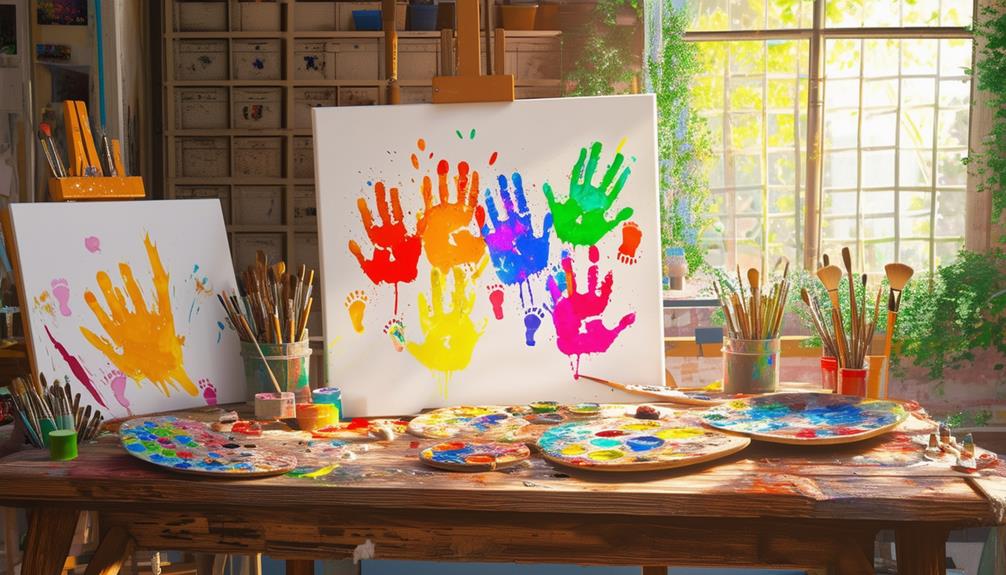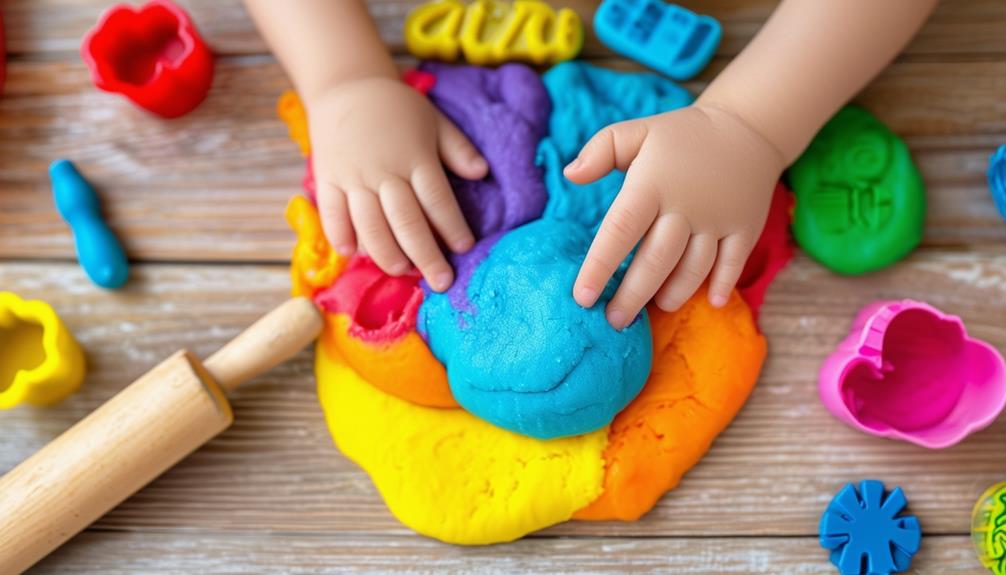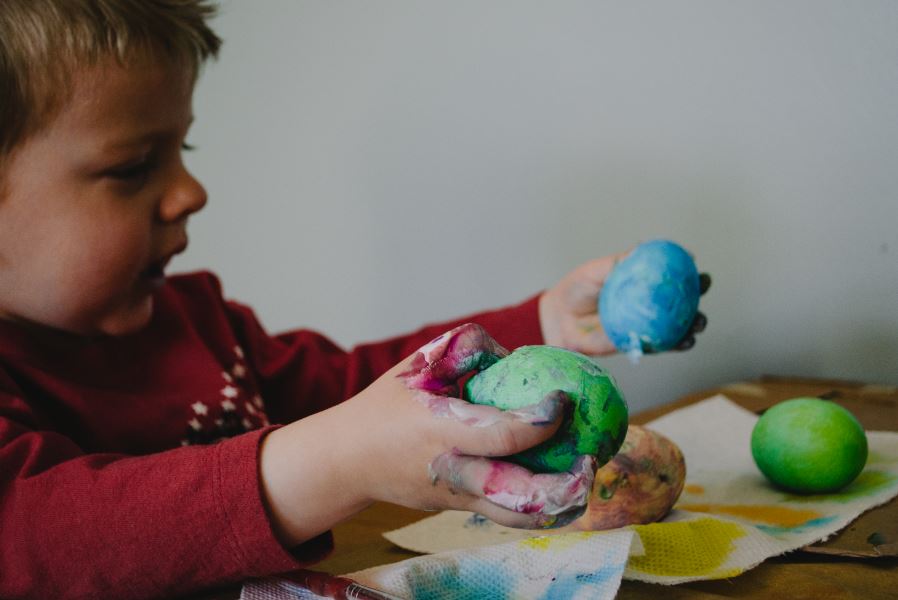Painting With Music: Creating Art to Different Rhythms and Sounds
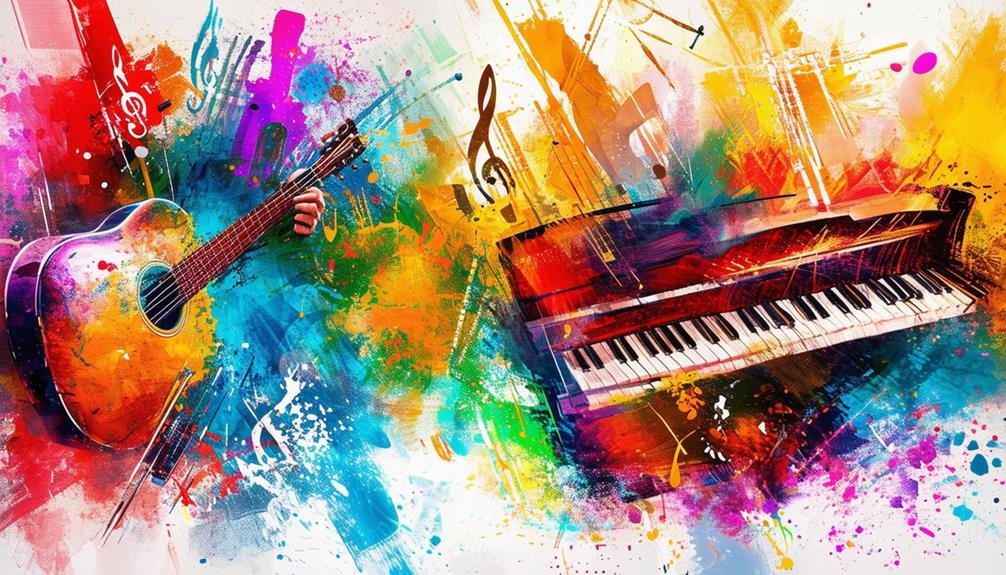
Imagine guiding your paintbrush across a canvas, letting the rhythm of a song dictate each stroke. Have you ever considered how aligning your art with music's tempo could transform your creative process? By tapping into the beats and melodies, you can infuse your work with dynamic energy or serene calm, mirroring the emotional essence of the sounds. This intersection of auditory and visual creativity opens up a new domain of artistic expression. Are you curious about how this synergy can enhance both your art and emotional resonance? Let's explore the profound connections between music and painting.
The Influence of Music
The profound connection between auditory and visual senses means that music can significantly influence an artist's creative process. Listening to music while creating art opens up a unique source of inspiration that can shape your work in unexpected ways. This relationship goes beyond serving as a mere background soundtrack; it becomes an integral part of the creative journey.
Cultural associations between music and visual art can also be a source of inspiration. The emotions and rhythms in a piece of music can guide your brushstrokes, translating auditory experiences into visual forms. Artists like Vasily Kandinsky famously incorporated musical elements into their paintings, drawing directly from the harmony and movement found in musical compositions.
Synesthesia in Art
Exploring the profound connection between auditory and visual senses, synesthesia in art takes this relationship to an extraordinary level. Imagine experiencing a vibrant New York cityscape through the eyes of a synesthetic artist. These artists don't just hear music; they see it. Each note, rhythm, and harmony translates into colors, shapes, and movements on their canvas.
Synesthesia can turn a simple melody into a visual symphony, where every stroke of paint reflects the music's emotional and rhythmic nuances. This unique phenomenon allows artists to create multi-sensory experiences, blending sound and sight in ways that might seem otherworldly to those without synesthesia.
Here's how different elements of music influence synesthetic art:
| Element of Music | Visual Perception | Artistic Impact |
|---|---|---|
| Rhythm | Repetitive patterns | Structured, rhythmic brushstrokes |
| Melody | Flowing lines and curves | Smooth, continuous motion in art |
| Harmony | Layered colors and textures | Rich, complex visual compositions |
| Volume | Brightness and intensity of hues | Vivid or subdued color palettes |
This table illustrates the synesthetic translation of musical elements into visual art, showcasing the deep, interconnected experience of sound and sight for synesthetic artists.
Emotional Impact
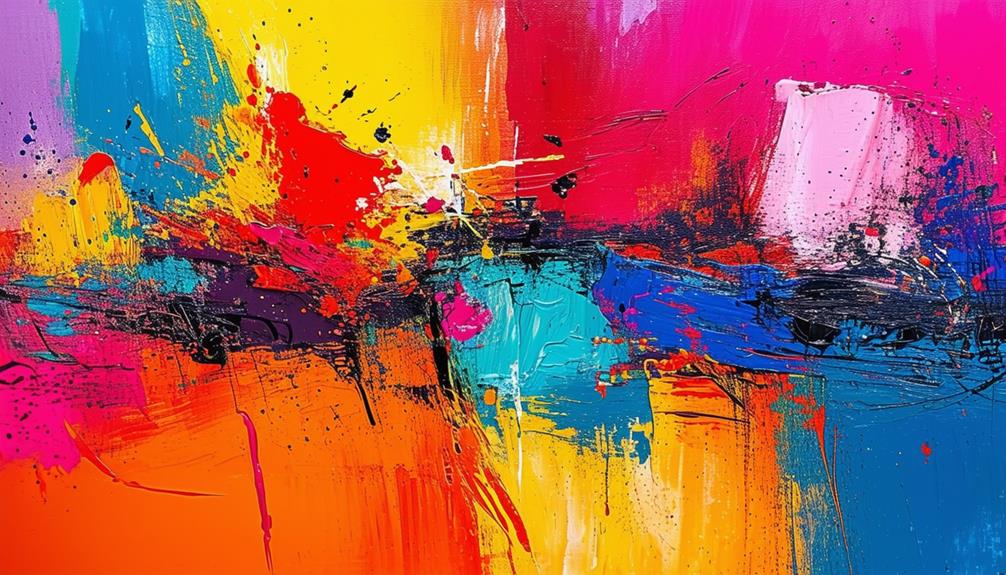
When you paint with music, you can evoke powerful emotions like joy and positivity. Melodies and rhythms guide your brush, translating sounds into vibrant colors and expressive strokes. This emotional connection enriches your creative process and deepens the viewer's experience, making the artwork resonate on a profound level.
Music Evoking Emotions
Listening to music while painting can profoundly influence an artist's emotional state, guiding their creative choices and enhancing the emotional depth of their artwork. The impact of music on art is significant and far-reaching. When immersed in the creative process, the music you choose can evoke a wide range of emotions—from joy and excitement to sadness and nostalgia.
Music has the power to inspire artists to express their innermost feelings and convey powerful messages through their art. Different genres of music can elicit specific emotions, influencing your color choices, brush strokes, and the overall mood of your painting. For instance, a classical piece might lead you to use softer, more flowing strokes, while a rock song could push you towards bolder, more aggressive movements.
Moreover, music serves as a catalyst for a deeper emotional connection between you, your artwork, and the viewer. This creates a harmonious and resonant experience that can be felt deeply by anyone who views your piece. By tapping into your emotions through music, you can channel those feelings into your paintings, making your art a profound and deeply personal expression.
Joy and Positivity
Painting with lively music can uplift your spirits, infusing your artwork with dynamic energy and cheerful expressions. When vibrant tunes fill your studio, it's almost impossible not to feel a surge of joy and hope. This positive emotional connection translates directly into your work, creating paintings that brim with vitality and color.
Lively music acts as a potent source of artistic motivation. While listening, you may find yourself gravitating towards vivid colors, exploring whimsical shapes, and applying energetic brushstrokes. The music's beat and melody can guide your hand, igniting your creative expression and prompting you to experiment with new techniques. This spirit of exploration often leads to compositions that mirror the delight you experience while painting.
The emotional influence of cheerful music on your artwork can yield pieces that exude joy and a zest for life. Viewers can perceive the optimism and dynamism infused in your paintings, leaving them feeling uplifted and motivated. By incorporating upbeat music into your painting process, you enrich your own creative journey and enhance the emotional experience of those who admire your art.
Benefits of Music
Incorporating music into your painting process can significantly enhance both your creativity and emotional expression. Allowing music to influence your artistic flow opens up new avenues for creative exploration that might otherwise remain untapped. The interplay between musical elements and visual art can result in distinctive and compelling artwork. Different genres and rhythms affect your brushstrokes and color choices, creating a cohesive bond between sound and canvas.
Consider how different types of music can shape your artwork:
| Music Genre | Possible Effects on Art |
|---|---|
| Classical | Smooth, flowing brushstrokes |
| Jazz | Dynamic, improvisational lines |
| Rock | Bold, energetic colors |
| Ambient | Calm, serene compositions |
Music establishes a rhythmic connection between you and your painting, making the process more immersive and enjoyable. This synergy allows for a vivid expression of emotions and ideas, enhancing both the creation process and the final artwork. The relationship between music and art can evoke profound emotional responses, enriching the overall experience. Next time you pick up a brush, play your favorite music and let the melody guide your masterpiece.
Rhythmic Connections
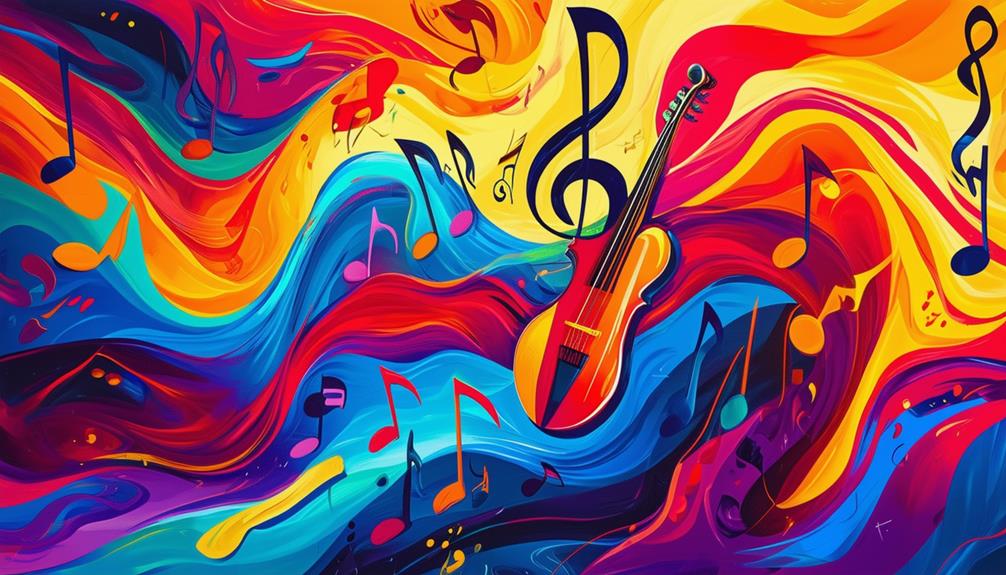
Synchronizing your brushstrokes with the beats of music infuses your artwork with vibrant energy and movement. Let the music guide your color choices and composition, creating a visual rhythm that mirrors the auditory experience. This synergy between rhythm and art can transform your painting into a dynamic and harmonious masterpiece.
Synchronizing Brushstrokes to Beats
Synchronizing brushstrokes with musical rhythms infuses a palpable pulse and energy into your artwork. This creative expression allows you to align your artistic process with the music's tempo, making each stroke a visual representation of sound. By matching your brushstrokes to the beat, you transform auditory experiences into tangible art.
This synchronization influences your painting style, making your strokes more dynamic and intentional. Adjusting your painting speed and intensity to the music creates a sense of flow and motion, evident in the final piece. This rhythmic connection helps you discover new textures and patterns, resulting in a unique and vibrant composition.
Experimenting with different rhythms diversifies your artistic repertoire. Fast beats might lead to energetic, bold strokes, while slower rhythms could inspire more deliberate and intricate details. This practice enriches your art's aesthetic and deepens your understanding of how sound impacts visual art. Embrace this technique to bring new energy and expression to your paintings, making each piece a harmonious blend of music and art.
Musical Influence on Colors
Artists often find that different music genres evoke specific colors in their paintings, creating a vibrant interplay between sound and sight. For instance, calm music like soft jazz or classical often inspires blues and greens, embodying tranquility. In contrast, energetic music such as rock or pop tends to bring out fiery reds and yellows, reflecting its lively spirit. This connection stems from color psychology and music influence, where the mood of the music translates directly into color choices.
When working on your art, you can discover chromatic interpretations by associating certain instruments or sounds with particular hues. For instance, a deep bass might inspire darker shades, while a high-pitched violin could lead to lighter, more delicate colors. These rhythm connections between music and color can shape your visual expressions, turning each stroke into a reflection of the melodies you hear.
The tempo and intensity of the music also play significant roles. Fast, upbeat tempos might encourage you to use bright, saturated colors with high contrast, while slower tunes might result in softer, more harmonious color schemes. By embracing these vibrant melodies, you can create art that truly mirrors the auditory experience, making your visual expressions more dynamic and cohesive.
Emotional Rhythm in Art
Translating the emotional rhythm of music into visual art allows you to capture dynamic flow and energy in your paintings. As you listen to music, let the tempo and beat guide your expressive brushstrokes. Fast-paced rhythms might inspire quick, bold strokes, while slower, melodic tunes could encourage softer, more deliberate movements.
Incorporating rhythmic balance into your artwork is essential. Just as music has a natural ebb and flow, your painting should create a visual rhythm that feels harmonious. Pay attention to how different sections of your canvas interact, ensuring no area feels too heavy or too light. This balance helps convey the emotional movement you're drawing from the music.
Emotional movement in your artwork mirrors the feelings evoked by the music. If a piece of music makes you feel joyful, frustrated, or contemplative, channel those emotions directly into your art. Use colors, shapes, and lines that resonate with the emotional tones you're experiencing. By doing so, you create a powerful connection between the auditory and visual domains, offering viewers a multisensory experience deeply rooted in the emotional rhythm of the music.
Artistic Harmony
The fusion of music and painting creates a profound sense of artistic harmony, where each brushstroke mirrors the rhythm and emotion of the sound. By engaging in artistic interpretation, you can transform creative expressions into a visual language that speaks to the auditory influences surrounding you. Visual harmony naturally emerges when painting techniques align with the musical rhythms that guide your hand.
Imagine listening to a lively jazz piece; the tempo might inspire bold, swift strokes, while a gentle classical melody could lead to soft, flowing lines. Your artwork becomes a synchronized dance of color and form, reflecting the dynamic energy or serene calm of the music. This integration of music and painting not only creates aesthetically pleasing pieces but also evokes a deeper emotional resonance, offering viewers a multisensory experience.
Through this process, you delve into the relationships between colors, shapes, and movements, finding unity in the juxtaposition of sound and sight. The synergy of these elements fosters a cohesive artistic experience, where visual and auditory elements blend seamlessly, resulting in a piece that embodies the essence of artistic harmony. Your art becomes a vibrant symphony of visual and auditory delight.
Musical Inspiration
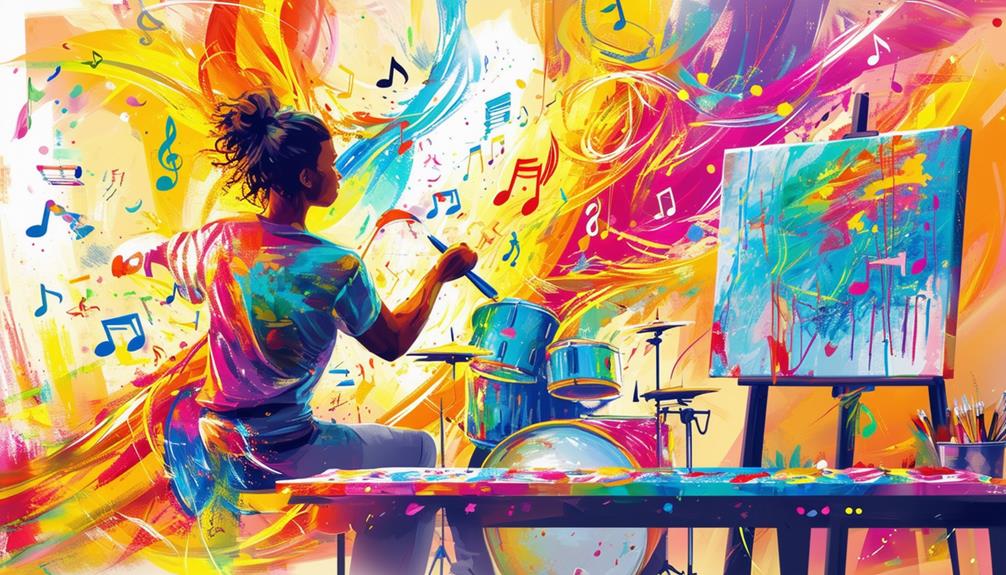
Listening to music while painting can create a unique fusion of sound and vision, enriching your creative expression. Different genres and instruments can evoke various emotions, adding unexpected textures and patterns to your work. This synesthetic experience allows you to translate rhythm and melody into vibrant visual art, enhancing both the auditory and visual dimensions of your creativity.
Synesthetic Artistic Experiences
Imagine experiencing a symphony's crescendo as a burst of vibrant colors splashing across a canvas. This is the essence of synesthetic artistic experiences, where sensory perceptions blend seamlessly to create harmonious expressions. Synesthesia, a condition where one sense involuntarily triggers another, allows some artists to perceive music as colors and shapes. This unique way of experiencing the world transforms auditory sensations into visual masterpieces.
Artists like Wassily Kandinsky have famously harnessed this ability, translating the rhythms and emotions of music into vivid, abstract paintings. You can almost see the notes of a clarinet as a swirl of blue or a drumbeat as a sharp streak of red. The connection between music and painting through synesthesia results in artworks that are not only visually stunning but also deeply resonant with the auditory experiences that inspired them.
When you look at these paintings, you're not just seeing with your eyes but also feeling the music through the artist's unique perspective. It's a mesmerizing exploration where sound and sight merge, offering an immersive experience that is both dynamic and profoundly engaging.
Emotional Musical Influence
Building on the captivating fusion of senses in synesthetic experiences, let's delve into how music's emotional power can influence an artist's creative process. Music acts as a powerful emotional stimulant, inspiring a spectrum of feelings and responses in artists. Different genres can affect your brushstrokes, color choices, and energy levels, shaping your artistic expression and interpretation.
This emotional resonance allows you to convey ideas, emotions, and moods through your artwork. By creating a harmonious link between sound and visuals, you can evoke elements such as harmony, rhythm, movement, and balance in your paintings. When painting with music, you're not just creating art; you're crafting visual melodies that deeply resonate with viewers.
The emotional influence of music in painting enables a deeper connection with your audience, eliciting diverse responses and interpretations. This transforms your artistic inspiration into a shared experience. By harnessing the emotional power of music, you can create artworks that captivate the eye and stir the soul, leaving a lasting impression through the harmonious blend of musical and visual artistry.
Abstract Elements
Incorporating abstract elements in painting with music allows artists to translate rhythm, tempo, and mood into vibrant shapes, colors, and textures. By focusing on rhythmic patterns and dynamic movements, you create a visual symphony that mirrors the music's pulse. Energetic brush strokes become your instruments, translating tempo into visual form. Faster tempos inspire quick, sharp lines, while slower rhythms lead to long, sweeping strokes.
Mood interpretation is crucial in this process. Music evokes diverse emotions, and you can capture these feelings through abstract shapes and color choices. A melancholic tune might inspire dark, muted tones, while an upbeat song could lead to bright, lively hues. This method enables you to express the essence of the music without relying on representational imagery.
Interpreting Sounds
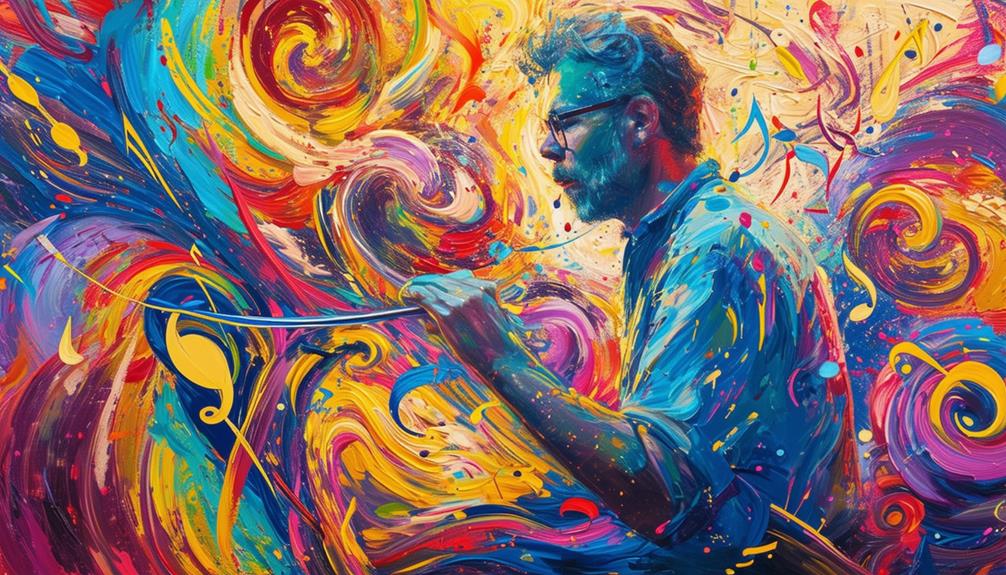
When interpreting sounds in your artwork, you'll translate each auditory element into a corresponding visual symbol. This process of sound visualization allows your sensory perception to guide your creative expression. For instance, a drumbeat's deep, resonant sound might inspire you to paint large red circles, with each rhythmic interpretation acting as a bridge between what you hear and what you create on the canvas.
Consider the sound of maracas. Their rhythmic, shaking noise could lead you to add black dots across your paper, each dot symbolizing a beat. The delicate ring of a triangle bell might evoke light blue wiggly lines, illustrating the sound's airy and fanciful nature. When you hear the croaking of an agogô, green zigzags could spring to life, capturing the sound's unique texture and irregularity.
Cymbals, with their loud, crashing resonance, might result in big, bright bursts of color, exploding across your canvas like a visual echo of the sound. Through these interpretations, your artistic inspiration blooms, heavily influenced by musical elements. By allowing each sound to guide your brush, you transform auditory experiences into vibrant, tangible art, seamlessly merging creative expression with musical influence.
Vasily Kandinsky's Legacy
Vasily Kandinsky's legacy highlights the profound connection between music and painting, rooted in his synesthetic experiences, which enabled him to hear colors and see sounds. This unique sensory perception significantly influenced his abstract paintings, characterized by geometric shapes and bold colors. His work often reflected the emotional and expressive qualities of music, adding a deeply spiritual dimension to his art.
Kandinsky's techniques have greatly impacted modern interpretations of the interconnectedness between music and art. Contemporary artists continue to draw inspiration from his methods, integrating musical elements into their visual creations. His ability to translate auditory experiences into visual forms has opened new dimensions of artistic expression.
Today, artists embrace Kandinsky's spiritual influences and techniques to create art that transcends traditional boundaries, offering viewers a multi-sensory experience. His pioneering work has left an indelible mark on the art world, encouraging ongoing exploration of how music can shape visual art.


